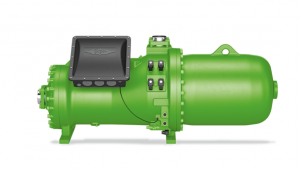При запуске винтового холодильного агрегата первым делом необходимо убедиться в том, что холодильная система работает нормально. Ниже приводится краткое описание содержания и признаков нормальной работы, приведенное ниже, и носит исключительно справочный характер:
Охлаждающей воды в конденсаторе должно быть достаточно, давление воды должно быть выше 0,12 МПа, а температура воды не должна быть слишком высокой.
Для винтовых холодильных агрегатов показания манометра масляного насоса должны быть на 0,15~0,3 МПа выше давления нагнетания.

Температура масла ни при каких обстоятельствах не должна превышать 70 °C для фторированных холодильных установок и 65 °C для аммиачных, а минимальная температура не должна быть ниже 30 °C. При нормальных условиях эксплуатации смазочное масло не должно вспениваться (за исключением фторированных холодильных установок).
Температура нагнетания холодильного агрегата. Аммиак и R22 не превышают 135°C, и если температура выхлопных газов поднимется выше, она будет очень мала по сравнению с температурой вспышки холодильного масла (160°C), что неблагоприятно для оборудования. Поэтому, с точки зрения эксплуатации, температура выхлопных газов не должна быть слишком высокой, а если она слишком высокая, следует остановить агрегат и выяснить причину.
Уровень давления конденсации. Он определяется, главным образом, источником воды, конструкцией конденсатора и используемым хладагентом. Уровень жидкости в резервуаре должен быть не ниже одной трети указателя уровня жидкости, а уровень масла в картере не должен быть ниже горизонтальной осевой линии смотрового окна.
Автоматический возврат масла фтормасляного сепаратора работает нормально в холодном и горячем состоянии, а цикл охлаждения/нагрева составляет около 1 часа. Не должно быть заметной разницы температур до и после фильтра жидкостного трубопровода. Не должно быть инея, иначе он будет заблокирован. Фторированный холодильник должен быть холодным на плоской стороне и горячим на сухой стороне. Соединения фторированной системы не должны пропускать масло, что приводит к утечке фтора.
При прикосновении к горизонтальному конденсатору во время работы верхняя часть должна быть горячей, а нижняя – холодной. Место соединения холодной и горячей частей соответствует уровню жидкого хладагента. Маслоотделитель также горячий в верхней части, а нижняя часть не слишком горячая. Предохранительный или перепускной клапан холодильника должен быть холодным на стороне низкого давления. Если он не холодный, это указывает на утечку воздуха в зоне высокого и низкого давления.
Во время работы давление пара должно быть равно давлению всасывания, а давление нагнетания на стороне высокого давления должно быть равно давлению конденсации и давлению в ресивере жидкости. Если это не так, это является ненормальным.
При определённом расходе воды должна быть разница температур между входом и выходом охлаждающей воды. Если разницы нет или она очень незначительна, это означает, что поверхность теплопередачи теплообменного оборудования загрязнена и его необходимо остановить для очистки.
Сам холодильник должен быть герметичным и не допускать утечки хладагента и смазочного масла. Для уплотнения вала при стандартной холодопроизводительности 12,6×1000 кДж/ч допускается небольшая утечка масла, а для холодильников со стандартной холодопроизводительностью > 12,6×1000 кДж/ч допускается утечка масла не более 10 капель в час. В холодильном агрегате с фторсодержащим уплотнителем не должно быть подтеков масла.
Температура уплотнения вала и подшипников холодильника не должна превышать 70°С.
Иней или роса на регулирующем клапане должны быть равномерными, но на входе не должно быть толстого инея.
Время публикации: 13 марта 2023 г.




